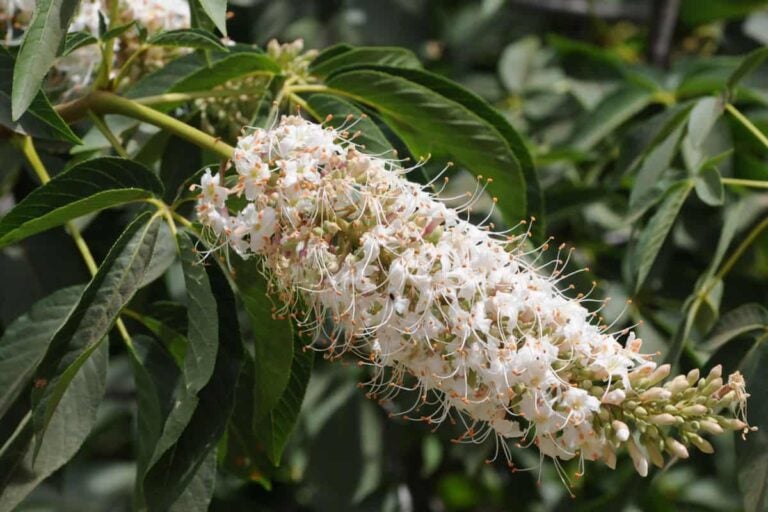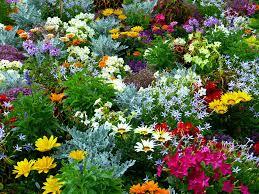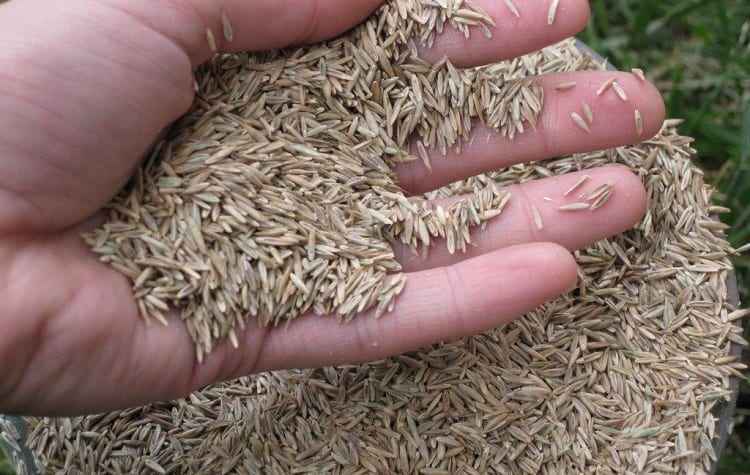Should I Use Bleach To Kill Grass And Weeds? Everything You Need To Know
Grass can look fantastic on a lawn, but sometimes it can also appear in places where we don’t want it to be.
You may be walking down your driveway one day and notice that grass is growing up in the middle of the cracks in your pathways, or you may notice some weeds sprouting there.
This can be pretty annoying, so it’s necessary to find a way to control the grass and weeds, and stop it from growing in those places.
Sure, it’s often possible to use herbicides to get rid of weeds, but what about grass? Well, it’s possible to use a homemade weed killer to get rid of grass and weeds, consisting of bleach such as clorox. How does this work? Well, we’re here with all of the answers.
If you want the fast answer, here it is. Get a little bit of undiluted bleach and put it in a spray bottle. Spray it all over the grass and weeds that you want to kill and allow it to stand there for around 3 days. This will allow the bleach to have time to get to the root, stopping it from growing again.
If you have grass and weeds on your patio, gravel or driveways, bleach is a great choice since it will ensure that you are permanently getting rid of the grass and weeds.
If you have plants or lawns you want to keep though, it’s not recommended to do this in those areas.
In most cases it’s actually much better to get rid of weeds using bleach because it’s not actually a selective DIY herbicide.
Always be careful when spot treating it though, since you don’t want to accidentally get bleach on plants that you want to keep around.
If you have ground cover vegetation in your garden though you can use a selective herbicide instead to save damage to any other plants that you do want around.
Is Bleach A Permanent Weed Killer?
You will be pleased to know that yes, bleach can act as a permanent killer for weeds and grass. This is because it can reduce the pH of the soil.
When this happens, it means that plants and weeds are unable to grow in the location where it is applied.
As such, it makes a good choice for spot treatment on driveways, rocks, gravel and pavers. The soil will be so acidic that nothing will grow there again.
With that in mind though, it’s extremely important that you do not attempt to put bleach on places like lawns, flower beds or anywhere else that has plants that you may want to thrive.
Bleach doesn’t just kill weeds and grass – it kills any kind of plant that it comes into contact with and it can have a massive effect on the pH of the soil for a long time afterwards, preventing you from growing things in the same place in the future.
That’s why it’s so important to be careful when applying bleach to remove weeds and grass.
Killing Weeds And Grass With Bleach: The Correct
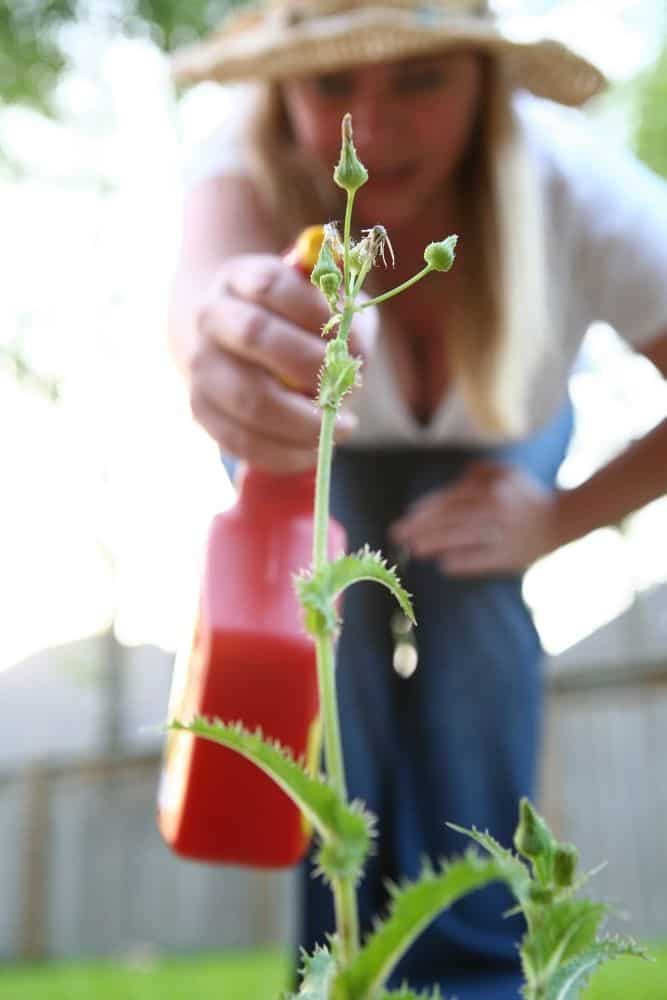
First, it’s worth noting that bleach contains particular amounts of chlorine. Now, if this is put on plants in very small amounts it can actually be good for them.
It’s when you apply chlorine to plants in large amounts that it becomes a problem. It will end up burning the plants and eventually the plants will die since they cannot handle the very acidic pH levels.
Using bleach to kill your weeds and grass is pretty simple. First, get a garden spray pump and put some bleach into it – make sure that the bleach is undiluted.
When you have done this, you can then work on spraying the solution over the weeds and grass that you want to get rid of, whether this is on your driveway, in your yard or in between the pavers.
When 2-3 days have passed you can apply more of the bleach onto the areas where the plants didn’t die.
Finally, pull away all of the dead weeds in order to keep your yard looking nice and clean.
It’s worth noting that diluted bleach solution applications may need to be repeated again numerous times on certain weeds and grasses, for instance creeping charlie, dandelions and crabgrass. These weeds are usually a lot harder to get rid of.
Bleach with chlorine in it can have a pretty big effect on weeds and plants. There are two main ways that it works. Bleach has a lot of sodium in it, and all of this sodium can overwhelm the plant’s internal systems.
Now, soil does actually occur naturally in soil, but if there’s too much of it present then the soil can suffer from something known as chlorine toxicity. This is just as dangerous to plants as it sounds.
The pH of the soil is also increased by a critical level too, since chlorine bleach has a pH level of 11.
If the soil contains high levels of pH then it can mean that it can’t take in all of the nutrients that it needs in order for plants to grow, such as iron, magnesium and calcium.
If the plants have basically been drowned in salt and they aren’t getting the nutrients that they need in order to survive, they can die as their leaves gradually turn brown and appear burned.
You won’t be able to plant anything in that soil once the bleach has managed to get into it since the soil will be in a poor state for plant growth.
Warnings And Considerations
It’s important to note that while bleach is an effective weed and grass killer, it can also be quite corrosive and will seriously damage your skin and eyes if you get it close enough to you.
Not only that, but if you are applying it near to concrete surfaces it can even damage and stain the surfaces in question.
You need to make sure, then, that you are very careful when you are trying to use bleach to manage the weeds and grass on your lawn.
Here are a couple of things that you need to take heed of when you are trying to kill weeds with bleach.
First of all, ensure that you are always wearing safety goggles and gloves to avoid damaging your eyes and skin.
Likewise, don’t spray the bleach when it’s windy outside, since the particles from the bleach can end up getting into your eyes or onto other parts of your body as the wind carries them.
Test out the spray before you put it all over the garden, and make sure that any dogs, children or elderly people are far away when you are spraying using this solution.
Don’t use too much bleach on the plants, and if more bleach is needed you can apply it a few days later instead.
Finally, do not attempt to mix the bleach with any other chemicals – you should always do some research first to double check how they could possibly react.
Also consider whether you may want to plant something in the same place any time soon. If that is your intention then you should wash it down using some water since this will reduce the acidity of the soil.
You can then keep on flashing the soil with water for a couple of months until it’s finally time to plant. When you are planting, use a little bit of fertilizer and manure in order to cancel out some of the acidity of the soil.
You can check the soil to see if the pH is back to normal using a soil pH meter.
Other Options For Weeds
There’s often a large amount of chlorine in bleach.
As we have already established, this bleach can be incredibly bad for any soil in your yard, making it uninhabitable for any plants for a long time after the bleach has been applied.
There are many organisms that may not even survive if you do apply bleach in order to get rid of weeds.
If this is an issue, then here are a couple of bleach based weed killers that you can make at home.
Dawn Dish Soap And Bleach
This solution is simple to make – all you need is to add together a cup of water with a cup of clorox.
Then, put some dish soap into this combined solution, mix them together well and you have what you need to kill the weeds in your garden.
Put it into your garden sprayer as you would with ordinary bleach and then spray the plants that you need to kill in the walkways, driveways and anywhere else.
Allow this solution to sit on the area for roughly 3 days maximum in order to let it fully kill the weeds.
It’s a good idea to know that the dish soap is a surfactant in how it acts, and this means that the bleach is more likely to stick to the leaves. This makes it more likely that it will actually kill the weeds.
Bleach And Vinegar
Vinegar works really well for killing weeds, even without any dilution. When used in combination bleach and vinegar are the perfect team for getting rid of any weeds or grass standing in your way.
It’s not a good idea to dilute them both together if you have a huge weed issue.
The best thing to do is to put the vinegar right onto the weeds on your driveway or in between the pavers, and this will stop the weeds from coming back and will get rid of them.
When you have applied the vinegar, you can then spray the plants using some bleach to get the weeds gone for good.
Best Places To Use Homemade Bleach Weed Killer
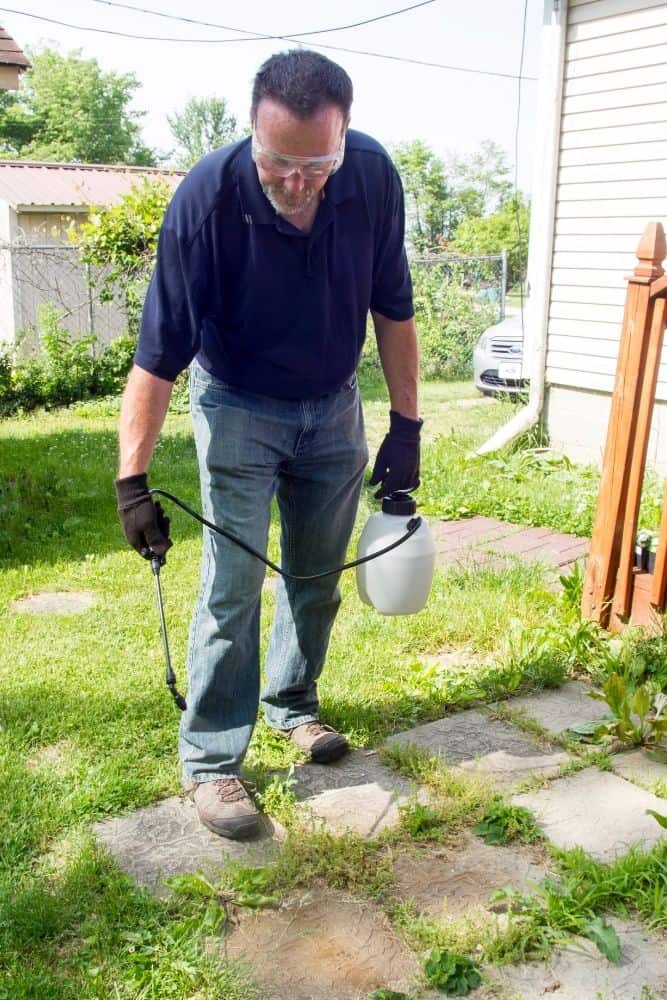
Some places are certainly better than others when it comes to using bleach. It may not be the best idea around a million other plants that you want to keep, but if weeds have sprouted in between your pavers and driveways, then it works perfectly there.
Since it’s difficult to manually remove the weeds from these locations with your hands, bleach can help to kill the plant at the root and stop it sprouting again.
Paths And Driveways
Weeds are quite commonly found in cracks in pavements and driveways since the seeds from the plants can be carried to these places by the wind.
Nobody wants weeds growing on their driveway, so bleach works well here. Just pour a little bit of undiluted bleach on top of the weeds and allow it to soak in for around 2 or 3 days.
You can then pull out the weeds when they are dead to ensure that the driveways look clean. Smaller weeds can be taken out using scraping tools if necessary.
Just remember that there’s a chance that bleach can discolor concrete, so use it sparingly.
Rocks And Gravel
If you have a gravel driveway then you may already know of the annoyance of weed growth in this location.
If your gravel driveway is sprouting weeds then it’s best to use a bleach and vinegar combo in order to get rid of the plants.
Just spray the bleach on the weeds to get rid of them, and then do it again in around 2 or 3 days in order to ensure that the weeds are totally dead.
Pavers
Paver cracks can often be breeding grounds for weeds since they can get into the cracks quite easily.
In most cases things like broadleaf weeds can be pulled up just using your hands, but in some cases something stronger such as clorox will be needed.
This is ideal for getting rid of any vegetation and keeping it away permanently, making your pavers look clean in the process.

